The first of our Neighbourhood Spotlight series for #MondaysinMilan: today we discover Secret Isola with Waam Tours. Come and tour Isola with us, between street art, tradition and modernity.
Where is Isola?
Isola means ‘island’ in Italian. The Milan neighborhood that goes by the name of ‘Isola’ is exactly that; an urban island. Hemmed in on two sides by Garibaldi station and the rail tracks, Isola is an island in the physical sense of the word. It’s cut off – a separate entity, from the busy surrounds of Garibaldi, Corso Como and the gleaming Porta Nuova skyscrapers.
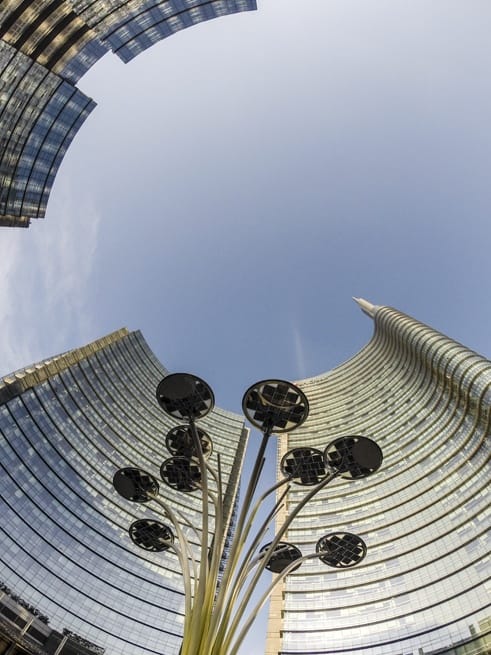
For this reason, Isola has always been a neighborhood with a strong local heart and a sense of community, a working class district where small shops and local trattorie still survive – albeit, nowadays, side by side with some of Milan’s coolest hangouts.
Isola has always fascinated me. I first explored its streets in 2003, after I was commissioned to write my very first article for a now defunct free press mag that – funnily enough – was also called Isola. I walked around for days, trying to put into words a feeling I did not yet know – the feeling of change, of a local soul developing into a hotbed for creativity. Some butchers and bakers of yesteryear were closing down, being replaced by organic delis, fusion restaurants and hip bars.
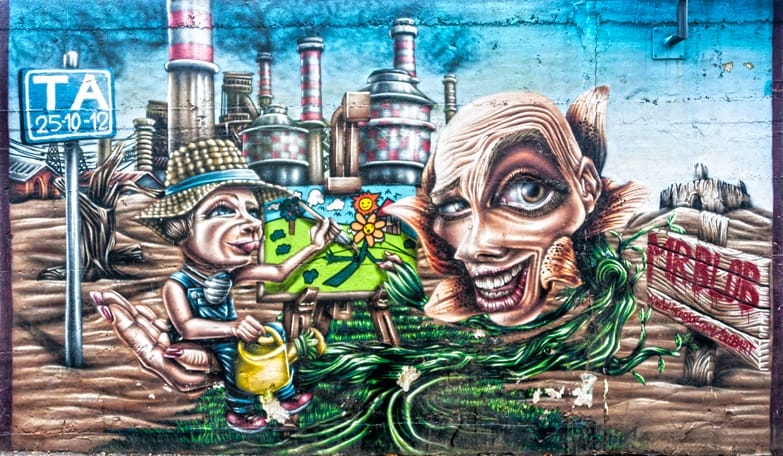
I searched and searched for the perfect sentence to start my very first article. Only to fail miserably. I ended up paraphrasing the old adage ‘every man is an island’ and turned it into ‘every city has its own island’, and my article never went to press.
Secret Isola with Waam Tours
Fast- forward eleven years, and I walked through the underground tunnel that connects Isola and Garibaldi station. The once-dilapidated tunnel that I used to cross a decade before is now covered in colorful wall paintings commissioned to a local art school.

On the other side, we met Veronica, Federica and Giulia, creators of WAAM Tours, offering alternative tours around Milan with a focus on art and uncovering little-known corners of the city. Our tour was called ‘Secret Isola’ and it included three main topics; street art, the beautiful Renaissance church Santa Maria alla Fontana (whose existence I ignored) and the newly-built Porta Nuova skyscrapers. Each of the three ladies would guide one section of the tour, based on their competence and passion.
Isola: The Heart of Milan Street Art
First off was Veronica, a street art enthusiast. She pointed to a sticker with the face of Arnold, the famous TV character interpreted by Gary Coleman. The sticker was no bigger than an A4 sheet of paper and we surely would have missed it, were it not for her.

Arnold’s portrait is the signature of Zibe, one of Milan’s best known artists. One way or another, he always features Arnold in his works – a reference to the stereotypical loser having his revenge on those who bullied him. But there’s also a personal reason for Zibe’s choice of Arnold as his signature. It’s a reference to one of Zibe’s childhood friends, plagued by the same feeling of inadequacy that Arnold experienced in the TV show, who ended up committing suicide.
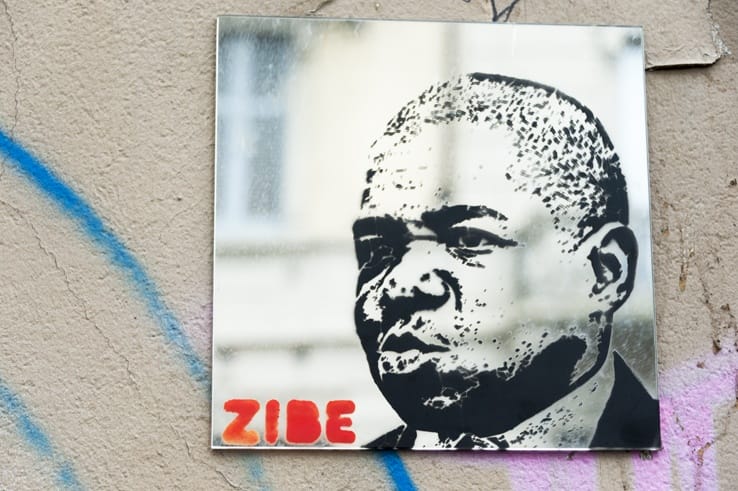
Zibe is the kind of street artist known as ‘bomberz’, that repeats the same imagery over and over again. Sure enough, as we wandered around, more and more Arnolds started to appear. A tiny one, on a traffic light pole. Another one near a street sign, and a giant one in the courtyard of Frida, a popular bar. The famous image is repeated to remind people not to forget the so-called ‘losers’, those on the bottom rung of this high-achiever society.
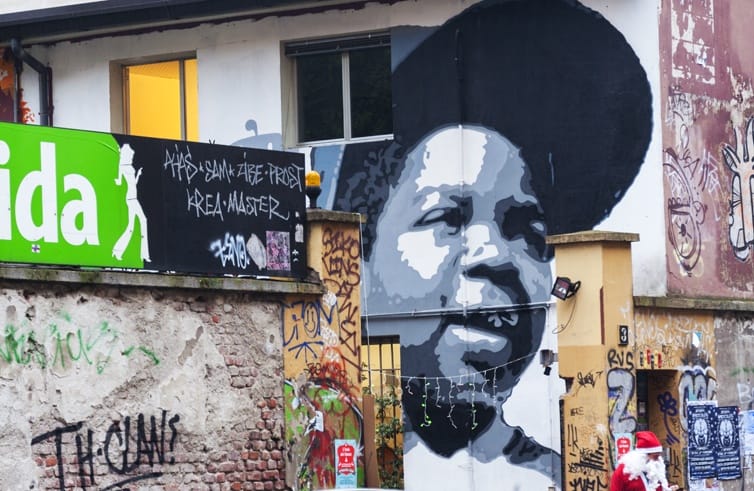
It was a Sunday afternoon and many shops were closed. Normally, it wouldn’t be a good idea to take a tour at this time of the week, but it’s the ideal time to see street art, as many pieces are painted on shop blinds. Veronica showed us a beautiful collaborative piece on the outside of a car repair shop. Zibe’s Arnold was at the centre, surrounded by works by half a dozen contemporary artists.
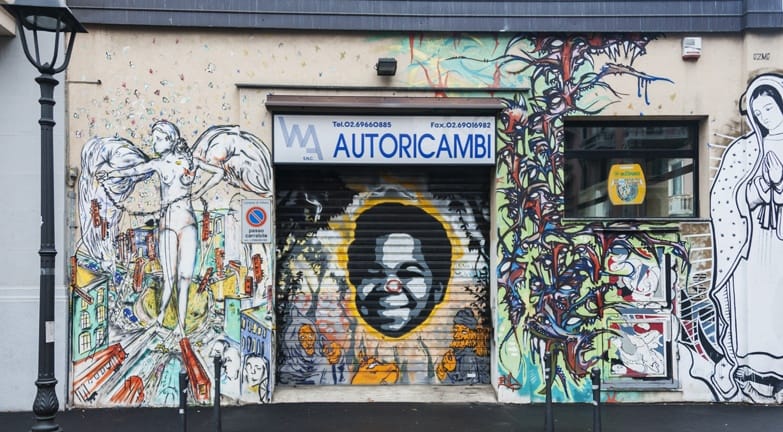
On Arnold’s left, there’s a Chagall-style piece by american artist Marvin Crusher, depicting an angel flying over Isola and Milan’s famous orange vintage trams. On the right, there’s a black and white Madonna painted over the corner of the building by Ozmo, an artist famous for its graphic approach to street art. The piece continues over the right side of the building, with contributions by artists like Microbo (‘germ’) and her signature imagery of floating micro organisms.

Unlike cities like Athens and Berlin, where street art has become a tourist drawcard, many Milan street artists still work in secret, as the public opinion often sees street art as vandalism; there seems to be no distinction between street art and writing, the practice of covering walls with one’s ‘tag’ (pseudonym).
Why is street art seen as vandalism?
Several excellent street artists live and work in Milan, and they all have seen their work painted over, removed or destroyed throughout the years. The city has lost the opportunity of becoming one of Europe’s street art capitals, retaining its ‘buttoned-up’ reputation. Let’s just hope public opinion will change, even though some masterpieces are irrevocably lost.
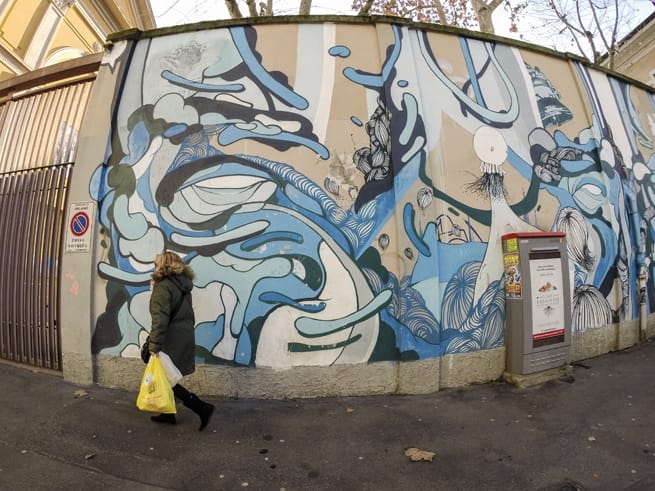
Veronica pointed to the wall, where the trace of a destroyed paste-up was still visible. It was the work of Pao, Veronica’s favourite artist, who uses the urban context as a canvas for his art. The silhouette of Mr Magoo was easy to recognize, with a curved gas pipe used as a walking stick. Some of his famous works include concrete traffic stoppers turned into penguins or dolphins, light poles that became daisies and public toilets painted like Campbell’s soups.
Pao’s art is a playful representation of the street art message as a whole – taking over the city, splashing drab, grey buildings with colours and positivity. The fact that somebody still feels the need to destroy a work that is not only beautiful, but also harmless and joyful, fills me with anger.
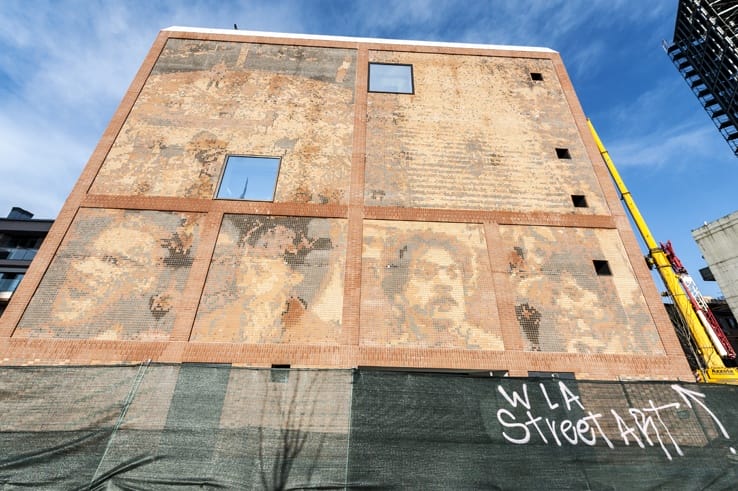
A Renaissance Jewel
But the tour was not over. A short walk from Isola’s street art we arrived at the beautiful church of Santa Maria della Fontana, built in the XV century, when this area was still open countryside. Our guide was Federica, a history of art teacher who specialises in the Renaissance. The church was built on a spring that had miraculous powers.
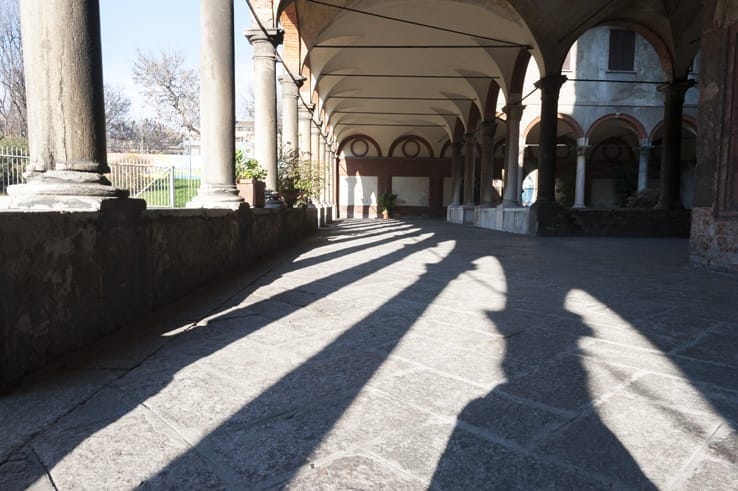
We bypassed the main section of the church and headed straight to the back, where Federica showed us the unusual plan, two side cloisters and a central one, which was rumored to have been planned by Leonardo da Vinci during his Milanese sojourn. The central cloister was built around the miraculous fountain, the water still tinkling from a dozen taps, with a pile of plastic cups inviting people to have a sip. Obviously, I couldn’t resist, and had a drink of miracle water while enjoying the still, tranquil atmosphere of the sanctuary.
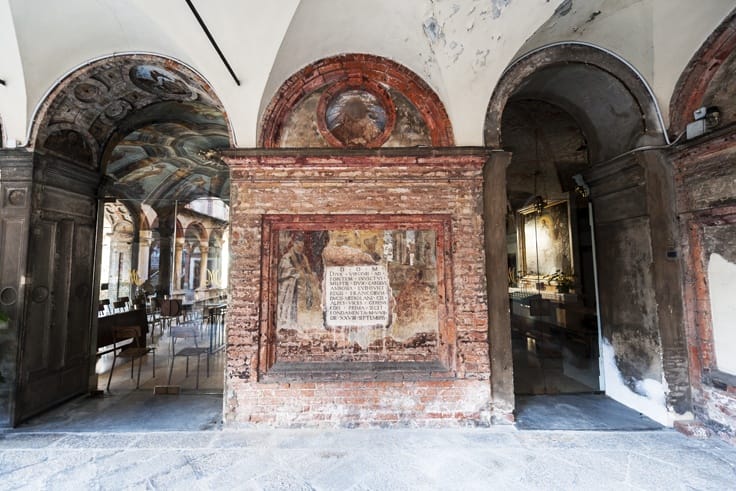
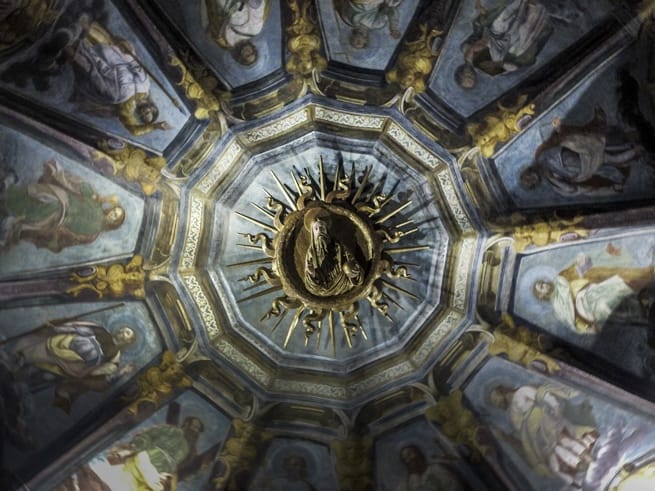
Modern Porta Nuova

Out of the church, the air was chilly and bitter. We were led by Giulia, an architecture enthusiast, to one of Milan’s most stunning sights. Bosco Verticale (Vertical Forest) is a recently-built complex of two residential buildings, where each flat has a terrace with a tree and bushes. The trees are barren in winter, but come spring they’re full of flowers, verdant in summer and showing off their multicoloured foliage in autumn.

We then followed a pathway lined to Piazza Gae Aulenti, the steel and glass heart of Milan, dominated by the imposing silhouette of the Unicredit building, the tallest in the city with its spire reaching 231 meters. A little statue of the Virgin Mary is placed on the top of the spire, in respect of the Milanese tradition that no building should ever be higher than the Madonnina atop the Duomo – as the saying goes, ‘man shall not overtake what God created’.

Giulia showed us the circular Piazza, hosting a Christmas market. Sleek benches towered by flower-like lights that absorb day light to be used at night occupied the centre. I had visited this place a few times and found it cold an uninviting, a poor imitation of London’s Canary Wharf and – dare I say – an awful waste of public funds.
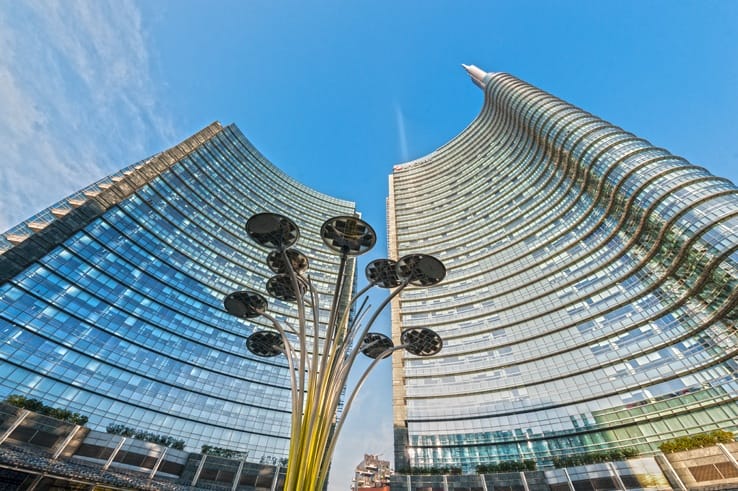
Observing it with Giulia, I appreciated details I hadn’t noticed before – the benches, the Le Corbusier’s like building on the left with its long, curved glass facade, an ironic reference to Milan’s ‘vertical craze’ of the last few years.

Just next to the building is Egg, a work by artist Alberto Garutti. The inner shaft of the parking area is surrounded by brass pipes, criss crossing each other, with openings on two different levels to allow people to communicate without being seen. I heard something and press my ear to one – ‘vaffanculo!’ said an 8 year old voice, accompanied by fits of giggles.
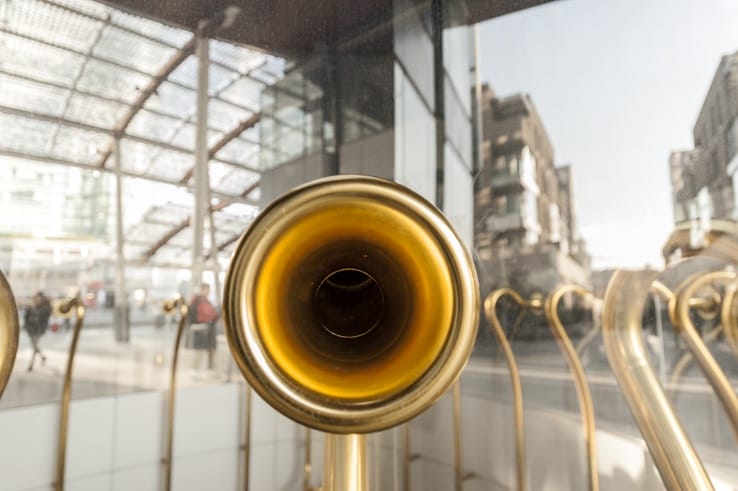
With his art work, Alberto Garutti makes people listen to the voices and sounds of Milan, with the aim of inviting citizens to take over urban spaces – the same message of street art.
Yet, in Milan, street artists (with few exceptions) still work in the shadows. Even pieces by well-known artists such as Pao are pulled out and damaged. A present day metaphor – the masses of young people struggle to survive on meagre wages, and to have their creativity and talent recognised while above, the fat cats are ever getting fatter.
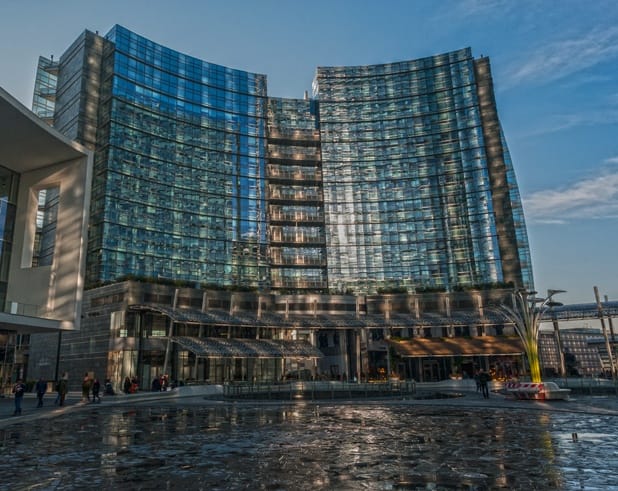
With this thought, I walked back towards the underground, glad to have experienced the different faces of Isola, and its contradictions – that, in a way, are a mirror if our own.

We would like to thank Veronica, Giulia and Federica of WAAM Tours for having invited us to join the tour. As always, all opinions are our own.

This would be just an extra reason for us to visit Milan, I like the idea of exploring this very interesting neighborhood with great street art and architecture too. It would be my kind of place to go to for sure 🙂
You guys would LOVE Isola. That’s where Milan’s alternative soul lives now. My favourite place in town – except for Lambrate, my own ‘hood!
An amazing afternoon!! The tour was absolutely gorgeous and the 3 girls are super!! Highly recommended for a tour in Milan!!
So true Ale – thanks for coming! 🙂
I’ve just returned from Milan and kept getting glimpses of the Unicredit building from various vantage points. Eventually I found my way to its roots and have been totally bowled over by its beauty.
Thanks so much Jane! Glad you liked Milan and the Unicredit building especially – I love it too!